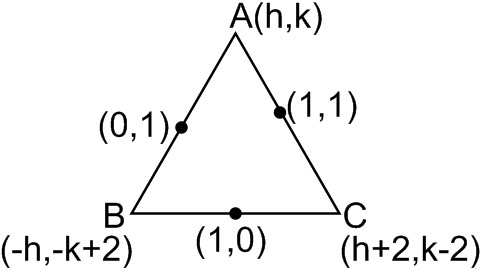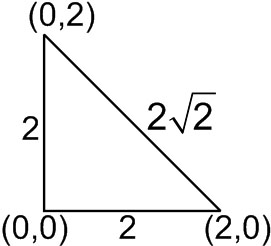Incenter of a Triangle: Formula, Properties and Examples
In this article, we will cover the concept of the Incenter. This category falls under the broader category of Coordinate Geometry, which is a crucial Chapter in class 11 Mathematics. It is not only essential for board exams but also for competitive exams like the Joint Entrance Examination(JEE Main) and other entrance exams such as SRMJEE, BITSAT, WBJEE, BCECE, and more. A total of eighteen questions have been asked on JEE MAINS( 2013 to 2023) from this topic including one in 2013, and one in 2023.
JEE Main 2025: Sample Papers | Mock Tests | PYQs | Study Plan 100 Days
JEE Main 2025: Maths Formulas | Study Materials
JEE Main 2025: Syllabus | Preparation Guide | High Scoring Topics
- Incentre: Definition
- Incentre of Triangle Formula
- Properties of an Incenter
- How to Construct the Incenter of a Triangle?
- Solved Examples Based on Incentre
.png)
Incentre: Definition
The incenter is the point of intersection of the internal angle bisectors of a triangle. And it is denoted by I.
It is the center of the circle which is inscribed in the triangle and touches all three sides of the triangle. This circle is the largest circle contained in the triangle. The incentre is equidistant from the sides of a triangle, as the central axis’s junction point is the center point of the triangle’s inscribed circle. The circle that is inscribed in a triangle is called an incircle of a triangle.
Incentre of Triangle Formula
The incenter is the point of intersection of the internal angle bisectors of a triangle. Let us get the coordinates of the incentre.
Let A (x1, y1), B (x2, y2), and C(x3, y3) be the vertices of the triangle ABC such as BC = a, CA = b and AB = c. Also, let AD, BE and CF be, respectively, the internal bisectors of the angles A, B, and C.
To find the coordinates of the incentre, we use the angle bisector theorem, that is ‘angle bisector divides the opposite side into segments, the ratio of which is equal to the ratio of other two sides of triangle’.
The coordinates of the Incentre (I) of the triangle, whose vertices are A (x1, y1), B (x2, y2), and C(x3, y3), are given by
$\left(\frac{\mathrm{ax}_1+\mathrm{bx}_2+\mathrm{cx}_3}{\mathrm{a}+\mathrm{b}+\mathrm{c}}, \frac{\mathrm{ay}_1+\mathrm{by}_2+\mathrm{cy}_3}{\mathrm{a}+\mathrm{b}+\mathrm{c}}\right)$
Where, a, b, and c are the length of side BC, CA, and AB respectively.

NOTE:
If ΔABC is an equilateral triangle, then a = b = c
Coordinates of Incentre (I) = Coordinates of Centroid (G) = $\left(\frac{\mathrm{x}_1+\mathrm{x}_2+\mathrm{x}_3}{3}, \frac{\mathrm{y}_1+\mathrm{y}_2+\mathrm{y}_3}{3}\right)$
Properties of an Incenter
Properties of the incentre of a triangle are:
1) A triangle's incenter always lies inside the triangle.
2) If $\mathrm{s}=(\mathrm{a}+\mathrm{b}+\mathrm{c}) / 2$, where s is the semi-perimeter of the triangle and r is the inradius of the triangle, then the area of the triangle is $\mathrm{A}=\mathrm{Sr}$
How to Construct the Incenter of a Triangle?
The construction of the incenter of a triangle is possible with the help of a compass.
Steps to construct the incenter of a triangle:
Step 1: Place one of the compass's ends at one of the triangle vertices. The other side of the compass is on one side of the triangle.
Step 2: Draw two arcs on two sides of the triangle using the compass.
Step 3: By using the same width as before, draw two arcs inside the triangle so that they cross each other from the point where each arc crosses the side.
Step 4: Draw a line from the vertex of the triangle to where the two arcs inside the triangle cross.
Step 5: Repeat the same process from the other vertex of the triangle.
Step 6: The point at which the two lines meet or intersect is the incenter of a triangle
Recommended Video Based on Incentre
Solved Examples Based on Incentre
Example 1: Let A (0, 1), B(1,1), and C (1,0) be the mid-points of the sides of a triangle with incentre at point D. If the focus of the parabola y2 = 4ax passing through D is$(\alpha+\beta \sqrt{3}, 0)$ , where $\alpha$ and $\beta$ are rational numbers, then $\frac{\alpha}{\beta^2}$ is equal to [JEE MAINS 2023]
Solution

$\begin{aligned} & \mathrm{a}=\mathrm{OP}=2 \quad \mathrm{~b}=\mathrm{OQ}=2 \quad \mathrm{c}=\mathrm{PQ}=2 \sqrt{2} \\ & (2,0) \quad(0,2) \quad(0,0) \\ & \mathrm{D}\left(\frac{4}{2+2+2 \sqrt{2}}, \frac{4}{2+2+2 \sqrt{2}}\right) \equiv \mathrm{D}\left(\frac{2}{2+\sqrt{2}}, \frac{2}{2+\sqrt{2}}\right) \\ & y^2=4 a x \Rightarrow\left(\frac{2}{2+\sqrt{2}}\right)^2=4 a \cdot\left(\frac{2}{2+\sqrt{2}}\right) \\ & \therefore 4 a=\frac{2}{2+\sqrt{2}} \therefore a=\frac{1}{2} \cdot \frac{2-\sqrt{2}}{4-2}=\frac{1}{4}(2-\sqrt{2}) \\ & \therefore \alpha=\frac{2}{4}=\frac{1}{2} \quad \beta=\frac{-1}{4} \\ & \therefore \frac{\alpha}{\beta^2}=8 \text { Ans }\end{aligned}$
Hence, the correct answer is 8.
Example 2: The $x-$ coordinate of the incentre of the triangle that has the coordinates of midpoints of its sides as (0,1) (1,1) and (1,0) is [JEE MAINS 2013]
Solution: The incentre of the triangle is given by
$I\left(\frac{a x_1+b x_2+c x_3}{a+b+c}, \frac{a y_1+b y_2+c y_3}{a+b+c}\right)$
- wherein
a,b,c is the length of the sides of ∆ ABC, and A(x1,y1) B(x2,y2) and C(x3,y3) are the vertices.

On solving h=0, k=2
Triangle becomes

$x-$ coordinate is $\left(\frac{a x_1+b x_2+c x_3}{a+b+c}\right)$
$=\frac{0+0+4}{2+2+2 \sqrt{2}}=\frac{4}{4+2 \sqrt{2}}=2-\sqrt{2}$
Hence, the answer is $2-\sqrt{2}$.
Example 3: Let the tangent to the circle $x^2+y^2=25$ at the point $R(3,4)$ meet the x-axis and y-axis at points P and Q, respectively. If r is the radius of the circle passing through the origin O and having centre at the incentre of the triangle OPQ, then $r^2$ is equal to :
Solution: Tangent to the circle x2 + y2 = 25 at R(3, 4) is 3x + 4y = 25

$\begin{aligned} & I \equiv\left(\frac{\frac{625}{12}}{\frac{25}{4}+\frac{25}{3}+\frac{125}{12}}, \frac{\frac{625}{12}}{\frac{25}{4}+\frac{25}{3}+\frac{125}{12}}\right) \\ & \therefore I \equiv\left(\frac{625}{75+100+125}, \frac{625}{75+100+125}\right) \equiv\left(\frac{25}{12}, \frac{25}{12}\right) \\ & \therefore r^2=\left(\frac{25}{12}\right)^2+\left(\frac{25}{12}\right)^2=\frac{625}{72} \\ & \end{aligned}$
Hence, the answer is $\frac{625}{72}$.
Example 4: The incentre of the triangle formed by the lines $\mathrm{y}=15,12 \mathrm{y}=5 \mathrm{x}$ and $3 x+4 y=0$ is:
Solution
The vertices of the triangle are $(36,15),(0,0)$ and $(-20,15)$ and the lengths of opposite sides are 25,56 and 39 respectively. Hence, the incentre is
$\left(\frac{25(36)+39(-20)}{120}, \frac{25(15)+(39)(15)}{120}\right)$.
On solving we get $(1,8)$
Hence, the answer is $(1,8)$
Example 5: The incentre of the triangle with vertices $(1, \sqrt{3}),(0,0)$ and $(2,0)$ is
Solution: Clearly, $\mathrm{AB}=\mathrm{BC}=\mathrm{CA}=2$
$\therefore \quad \triangle \mathrm{ABC}$ is equilateral
$\therefore$ The Incentre is the centroid.
$\therefore \quad$ Incentre is $\left(1, \frac{1}{\sqrt{3}}\right)$

Also Read
15 Feb'25 02:23 AM
15 Feb'25 02:19 AM
15 Feb'25 02:17 AM
15 Feb'25 02:04 AM
15 Feb'25 02:02 AM
15 Feb'25 01:55 AM
15 Feb'25 01:51 AM
15 Feb'25 01:47 AM
15 Feb'25 01:44 AM
15 Feb'25 01:44 AM